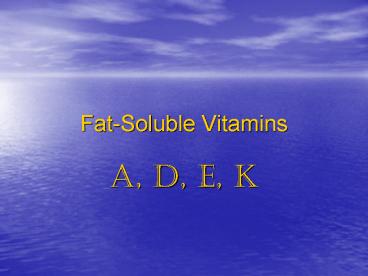Fat-Soluble Vitamins - PowerPoint PPT Presentation
1 / 20
Title:
Fat-Soluble Vitamins
Description:
Fat-Soluble Vitamins A, D, E, K Fat-Soluble Vitamins found in fats and oils require bile for absorption enter the lymph, then the blood held and stored in fatty ... – PowerPoint PPT presentation
Number of Views:428
Avg rating:3.0/5.0
Title: Fat-Soluble Vitamins
1
Fat-Soluble Vitamins
- A, D, E, K
2
Fat-Soluble Vitamins
- found in fats and oils
- require bile for absorption
- enter the lymph, then the blood
- held and stored in fatty tissues
- daily requirements need not be met
- may reach toxic levels
- not readily excreted
3
Vitamin A
- 3 forms in the body
- retinol
- retinal
- retinoic acid
- collectively known as retinoids
- found in food derived from animals
Retinol, the alcohol form
Retinal, the aldehyde form
Retinoic acid, the acid form
Cleavage at this point can yield two molecules of
vitamin A
Beta-carotene, a precursor
4
Vitamin A
- precursor beta-carotene
- derived from plant foods
- can split and form retinol in intestine and liver
5
Vitamin A
- promote vision
- small losses of retinal
- requires continual replenishment
- maintain epithelial tissue and skin
- mucous membranes
- support reproduction and growth
- sperm development
- fetal development
6
Vitamin A
- deficiency
- infectious disease
- pneumonia, measles, diarrhea
- keratinization
- dry, rough, scaly skin
- night blindness
7
Vitamin ADeficiency Symptom Night Blindness
A flash of bright light momentarily blinds you as
the pigment in the rods is bleached.
In dim light, you can make out the details
in this room. You are using your rods for vision
With inadequate vitamin A, you do not recover but
remain blinded for many seconds.
You quickly recover and can see the details again
in a few seconds.
8
Vitamin A
- toxicity
- yellow skin too much beta-carotene
- excess stored under skin in fat
- weaken bones
- found in
- colorful vegetables
- liver
9
Micrograms RAE
Food Serving size
(kcalories)
RDA for men
RDA for women
VITAMIN A Dark green and deep orange vegetables
(green) and fruits (purple) and fortified foods
such as milk contribute large quantities of
vitamin A. Some foods are rich enough in vitamin
A to provide the RDA and more in a single serving.
Vitamin A in Selected Foods
10
Vitamin D
- body can make
- from sunlight
- precursor made from cholesterol
- not essential
- production occurs in liver and kidney
- diseases can affect activation
11
Vitamin D
- target tissue
- intestines, kidneys, bones
- part of the bone-making/maintenance team
- maintains blood concentrations of Ca P
- deficiencies
- ultimately creates a calcium deficiency
12
(No Transcript)
13
Vitamin D
- toxicity
- most common in vitamin D
- excess vitamin D increase in blood calcium
stones or hardening of blood vessels
14
Vitamin D
- sources
- fortified food milk, margarine, cereals, beef,
eggs - sun
- 10-15 minutes several times a week
- dark pigmented skin needs more
- 3 hours 30 minutes
- storage from the summer does not last the winter
15
Vitamin D Synthesis and Latitude
16
Vitamin E
- antioxidant
- defender against free radicals
- polyunsaturated fatty acids
- may reduce the risk of heart disease
- deficiencies
- rare
- erythrocyte hemolysis
- preemies destruction of red blood cells
17
Vitamin E
- toxicity
- rare
- may interfere with blood-clotting mechanisms of
vitamin K - widespread in food
- easily destroyed by heat processing
18
Vitamin K
- aids in blood clotting
- deficiency causes hemorrhagic disease
- toxicity
- not common
- sources
- made by bacteria in GI tract
- absorbed and stored in liver
- ½ of needs
19
- liver is also high in vitamin K
20
Vitamin A, D, E, K Recommendations
VITAMIN RDA UPPER LEVEL
A 700-900 ug 3,000 ug
D 5-15 ug 50 ug
E 15 mg 2000 mg
K 90-120 ug none































